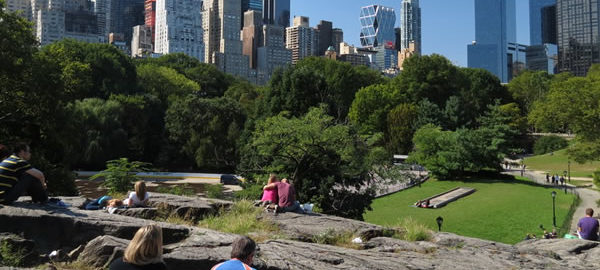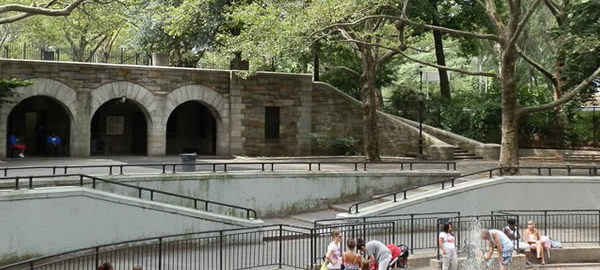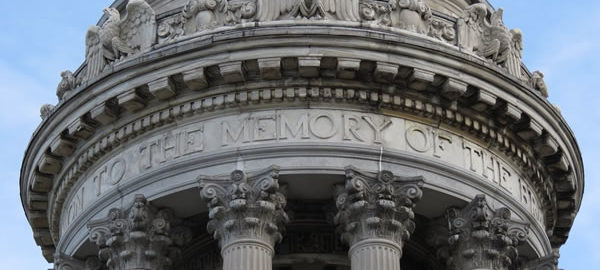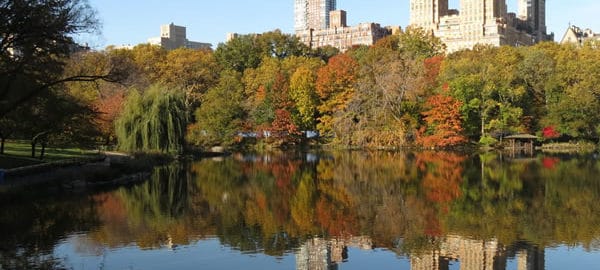End-of-summer views around some of Central Park’s many ponds and lakes.
Central Park’s idyllic views are among the most-photographed, most-painted scenes of New York, usually expressing “nature within the city.” Yet this “nature” is almost totally invented, created by Frederick Law Olmsted and Calvert Vaux.

Central Park Grand Tour
Central Park is a magnificent piece of architecture – parkitecture, if you will – for make no mistake, the 843-acre landmark is man-made, constructed in 1858-1873. It was designed by Frederick Law Olmsted and Calvert Vaux, the same team that later designed Brooklyn’s Prospect Park. You could easily take a week or two to explore all of Central Park’s nooks and crannies – there are close to 200 named attractions within the park.
While it may seem strange that a park should be engineered, there is method to the madness. For example, entrance paths were laid out with sharp turns so that a screen of trees was quickly placed between the visitor and the city. Cross-park traverses at 66th, 79th, 85th and 97th Streets were sunk below grade level to make them disappear into the landscape.
This “Grand Tour” of 100+ slides covers the high points – but we’ll need several installments to really show the entire park. You may be interested in the companion gallery, focusing on Bethesda Fountain.
You may also be interested in learning more about Central Park from Central Park Conservancy, the private non-profit group that maintains the park in cooperation with New York City. Visit their site at www.centralparknyc.org.
Enjoy!
Getting There: Central Park is surrounded by 15 subway stations: N, R, and Q at Fifth Avenue/59th Street; A, B, C, D, and 1 at Columbus Circle; B and C along Central Park West at 72nd, 81st, 96th, 103rd and 110th Streets; 2 and 3 at Lenox Avenue/ 110th Street; 4, 5, and 6 along Lexington Avenue at 59th, 68th, 77th, 86th, 96th, 103rd and 110th Streets (walk 3 blocks west). Paths are NOT well marked. If you want to explore, you really need a detailed map! Make The Dairy/Visitor Center your first stop. It’s just south of the 65th Street Transverse, about midway through the park.

Riverside Park
Riverside Park is another creation of Frederick Law Olmsted and Calvert Vaux – the powerhouse team who also designed Central Park and Prospect Park.
Riverside Park extends from 72nd Street to 158th Street along the Hudson River. It was built in 1875-1910; Robert Moses expanded and enhanced the park during the 1930s – adding the Henry Hudson parkway and covering up the former New York Central tracks, which had cut off access to much of the park. In the 1990s, Riverside Park South was created over the former Penn Central rail yards, in a Donald Trump-led development. (This photo gallery covers Riverside park’s main section, 72nd-125th Street.)
More information is available at the Parks Department and Riverside Park Fund sites: www.nycgovparks.org and www.riversideparkfund.org/.

Riverside Drive
Riverside Drive was designed by Frederick Law Olmsted – part of the package with Riverside Park. As part of the park’s scheme, the route is scenic – full of curves, dips and rises – not straight as the city’s grid pattern would dictate. The buildings along Riverside Drive try to live up to the scenic expectation; most were built in the era when lavish decoration and detailing were fashionable.
Riverside Drive extends from West 72nd Street to 153rd Street; this photo gallery covers the area up to 123rd Street.

![Central Park Reflections: CP13 [] Central Park Reflections: CP13 []](https://www.newyorkitecture.com/wp-content/gallery/central-park-reflections/CP13.jpg)
![Central Park Reflections: CP24 [] Central Park Reflections: CP24 []](https://www.newyorkitecture.com/wp-content/gallery/central-park-reflections/CP24.jpg)
![Central Park Reflections: CP23 [] Central Park Reflections: CP23 []](https://www.newyorkitecture.com/wp-content/gallery/central-park-reflections/CP23.jpg)
![Central Park Reflections: CP22 [] Central Park Reflections: CP22 []](https://www.newyorkitecture.com/wp-content/gallery/central-park-reflections/CP22.jpg)
![Central Park Reflections: CP21 [] Central Park Reflections: CP21 []](https://www.newyorkitecture.com/wp-content/gallery/central-park-reflections/CP21.jpg)
![Central Park Reflections: CP20 [] Central Park Reflections: CP20 []](https://www.newyorkitecture.com/wp-content/gallery/central-park-reflections/CP20.jpg)
![Central Park Reflections: CP19 [] Central Park Reflections: CP19 []](https://www.newyorkitecture.com/wp-content/gallery/central-park-reflections/CP19.jpg)
![Central Park Reflections: CP18 [] Central Park Reflections: CP18 []](https://www.newyorkitecture.com/wp-content/gallery/central-park-reflections/CP18.jpg)
![Central Park Reflections: CP17 [] Central Park Reflections: CP17 []](https://www.newyorkitecture.com/wp-content/gallery/central-park-reflections/CP17.jpg)
![Central Park Reflections: CP16 [] Central Park Reflections: CP16 []](https://www.newyorkitecture.com/wp-content/gallery/central-park-reflections/CP16.jpg)
![Central Park Reflections: CP15 [] Central Park Reflections: CP15 []](https://www.newyorkitecture.com/wp-content/gallery/central-park-reflections/CP15.jpg)
![Central Park Reflections: CP14 [] Central Park Reflections: CP14 []](https://www.newyorkitecture.com/wp-content/gallery/central-park-reflections/CP14.jpg)
![Central Park Reflections: CP01 [] Central Park Reflections: CP01 []](https://www.newyorkitecture.com/wp-content/gallery/central-park-reflections/CP01.jpg)
![Central Park Reflections: CP12 [] Central Park Reflections: CP12 []](https://www.newyorkitecture.com/wp-content/gallery/central-park-reflections/CP12.jpg)
![Central Park Reflections: CP11 [] Central Park Reflections: CP11 []](https://www.newyorkitecture.com/wp-content/gallery/central-park-reflections/CP11.jpg)
![Central Park Reflections: CP10 [] Central Park Reflections: CP10 []](https://www.newyorkitecture.com/wp-content/gallery/central-park-reflections/CP10.jpg)
![Central Park Reflections: CP09 [] Central Park Reflections: CP09 []](https://www.newyorkitecture.com/wp-content/gallery/central-park-reflections/CP09.jpg)
![Central Park Reflections: CP08 [] Central Park Reflections: CP08 []](https://www.newyorkitecture.com/wp-content/gallery/central-park-reflections/CP08.jpg)
![Central Park Reflections: CP07 [] Central Park Reflections: CP07 []](https://www.newyorkitecture.com/wp-content/gallery/central-park-reflections/CP07.jpg)
![Central Park Reflections: CP06 [] Central Park Reflections: CP06 []](https://www.newyorkitecture.com/wp-content/gallery/central-park-reflections/CP06.jpg)
![Central Park Reflections: CP05 [] Central Park Reflections: CP05 []](https://www.newyorkitecture.com/wp-content/gallery/central-park-reflections/CP05.jpg)
![Central Park Reflections: CP04 [] Central Park Reflections: CP04 []](https://www.newyorkitecture.com/wp-content/gallery/central-park-reflections/CP04.jpg)
![Central Park Reflections: CP03 [] Central Park Reflections: CP03 []](https://www.newyorkitecture.com/wp-content/gallery/central-park-reflections/CP03.jpg)
![Central Park Reflections: CP02 [] Central Park Reflections: CP02 []](https://www.newyorkitecture.com/wp-content/gallery/central-park-reflections/CP02.jpg)